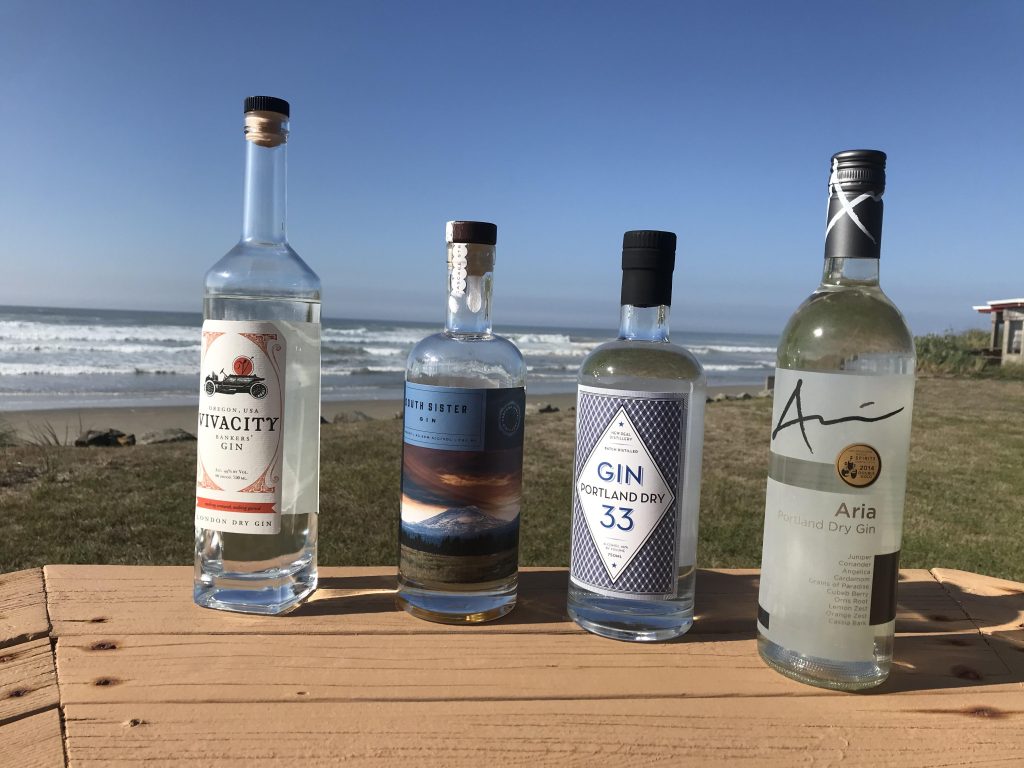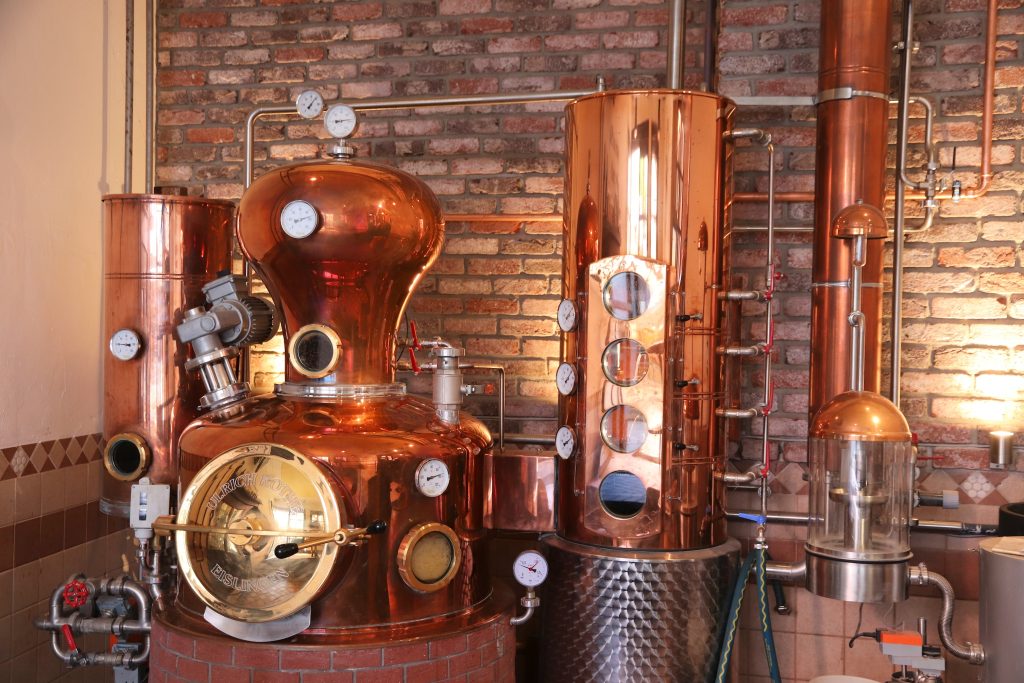
By: Becky Garrison
On September 23, 2022, Aviation Gin celebrated the opening of the Aviation American Gin Distillery and Visitor Center. Per their press release, “this state-of-the-art, nearly 33,000-square-foot facility features an intimate tasting room, exceptional draft cocktail bar and gift shop.” This facility has been in development since Diageo acquired Aviation American Gin with the Davos Brands portfolio in 2020.
The spacious tasting room and well-stocked gift shop modeled after a 1960s-era airline terminal, with airplane-related artifacts, photographs and ad posters to give the space a distinctive Mad Men vibe. A life-size cutout of co-owner and actor Ryan Reynolds greets visitors, while video clips featuring Reynolds create a Hollywood-esque feel. In describing his new venture, Reynolds’ issued this statement: “If a grown-up theme park and a bartender fell in love and produced offspring, it would be this gin factory.”
Educational tours allow visitors to fully immerse themselves into the Aviation experience through interactive experiences, such as connecting with the various botanicals used in making Aviation gin and a sneak peek at Reynolds’ office. This space doubles as an escape room, inviting guests to solve a series of puzzles and identify various “Easter eggs.” Fans of Deadpool and other Reynold’s flicks will find this exercise particularly amusing.
When asked why they chose to build this distillery in the industrial section of Northwest Portland nicknamed “Slabtown,” distillery director Hollie Stephenson stated, “This specific space is in a great location, meets operational needs and provides us with a place to give the brand an official homebase. Portland is a vibrant city with a rich, unrivaled spirits and cocktail scene, and we’re so glad that we can provide consumers and Aviation fans with the opportunity to visit a space that is dedicated solely to Aviation American Gin, where they can sip and learn about how our premium, uniquely American-style gin is distilled.”
Stephenson describes the company culture at Aviation Gin as lively, with a 25-member team of dedicated, hard-working, creative and kind people. “We work hard, support each other and of course, have fun,” she notes. At present, they bottle roughly 15,000 bottles per day. For the foreseeable future, they plan on focusing on the production of what Stephenson describes as a “unique American-style gin that is crafted with a blend of botanicals.”
While the bulk of the mainstream media coverage surrounding this opening of Aviation Gin focused on the Hollywood-esque nature of the experience, the history behind this iconic brand was lost in this coverage. As reported in Northwest Travel & Life, when Christian Krogstad and his wife launched House Spirits Distillery in Portland, Oregon in 2004, he took the innovative streak he developed as a brewer to collaborate with bartender Ryan Magarian to produce a “new western gin” inspired by the Aviation Gin Cocktail. This gin’s original, balanced blend of botanicals included cardamom, coriander, French lavender, anise seed, sarsaparilla, juniper and two kinds of orange peel.
With the introduction of this distillery into the neighborhood, visitors can now plan a self-guided walking tour of the area’s distilleries with Bull Run Distillery, Aria Gin and Freeland Spirits – all within easy walking distance and the last two distilleries known for their craft gins.
Aria Gin is located south of Aviation at 2304 NW Savier Street. This company’s Aria Portland Dry Gin (45%ABV) offers a classic London gin experience, and the distillery offers tasting flights and specialty cocktails, along with the opportunity to purchase a range of bar accessories, mixers and other products for those desiring to try their hand at making craft gin cocktails at home. The pristine Bull Run water used to distill Bull Run Distillery’s gin speaks to this gin’s origins in the Pacific Northwest. In addition, they collaborate with other producers, such as Ken Wright Cellars in Carlton, Oregon, to create cask-finished gins. They produce Distiller’s Reserve Gins, limited edition releases with unique barrel finishes as well.
Freeland Spirits, a women-owned distillery has a homey, welcoming feel. Founder Jill Kuehler found inspiration for her Meemaw Freeland garden gin in selecting the fresh Pacific Northwest botanicals. When possible, they source their botanicals from local producers, such as the woman-owned farm, Vibrant Family Farm. Also, they partnered with Wildwood Candle Co. to produce a candle with an aroma reminiscent of the botanicals used in making their gin. In addition to their gin (45%ABV), they distill a dry gin (57%ABV), a Navy-strength gin made with a high juniper content and a subtle herbaceousness. Also, they produce gin & tonic and French 75 canned cocktails. Tasting flights, mini cocktails and small snacks are available at their tasting room, along with distillery tours.
Other Portland Distilleries
That Produce Gin
Following are other distilleries located in Portland that distill gin with their unique craft focus.
• 503 Distilling’s use of Oregon juniper, fresh-cut spruce tips, gardened rosemary and other herbs in their Circa 17 gin (43% ABV) speaks to the terroir of the Pacific Northwest.
• The Aimsir Distilling Company, a husband and wife-owned distillery, features spirits like their Aitil House Gin (ABV 45%) that focus on local Pacific Northwest resources. Other local influences include their seasonal Rosé Gin distilled from Willamette Valley wines and their Holiday Gin made with mulling spices and barrel-aged in pinot noir barrels.
• New Deal Distillery offers three gins: New Deal Gin No. 1 (45% ABV), New Deal Old Tom Gin (45% ABV) and Portland Dry Gin 33 (46% ABV).
• Shine Distillery & Grill features their Batch One Gin (45% ABV) and a very hibiscus-forward Pink Hibiscus Gin (42.5% ABV).
• Stillweather Spirits offers an American Gin (45.4% ABV) described as London Dry meets Pacific Northwest New World and a contemporary style West Coast Gin (42% ABV).
• Wild Roots Spirits produces handcrafted gins in three varieties: London Dry Gin (46% ABV), Orange & Bergamot Gin (44% ABV) and Cucumber & Grapefruit (44% ABV).
Oregon Gins with a Portland Presence
While JAZ Spirits is distilled in Albany, Oregon at Vivacity Spirits, a woman-owned distillery, most of their business presence is in the Portland area, where founder Faith Dionne lives. Their JAZ Spirits Dry Gin (45%) and JAZ Spirits Old Tom Gin paint a picture of Oregon forests. The idea for Riverain Dry gin came from one of Dionnes favorite spots in Mount Hood National Forest on the upper Clackamas River. “Smooth basalt boulders, rippling snowmelt and a lush riverbank of cottonwoods and Douglas fir are the inspiration for the botanicals in our Dry Gin. We hand-forage sticky cottonwood buds and wind-fallen Douglas fir from that same riverain forest in late winter,” Dionne opines.
Also, Pilot House Distilling’s distillery is based outside Portland in Astoria, Oregon. However, they have tasting rooms in Portland and Cannon Beach, where visitors can sample their ranges of spirits, including their variety of gins. Their current selections of gins include Painted Lady gin, a new American style. A barrel-aged version of the Painted Lady, which is aged in pinot noir barrels from the Willamette Valley, and a London dry-style gin. In creating the Painted Lady Gin, Lawrence Cary, the original founder of PHD, wanted to produce a gin that even gin-haters love. He began playing around with different recipes until he found the perfect one, Painted Lady. This gin contains hints of lavender, rose hips and chamomile, with a name that speaks to Astoria’s history. The name, Painted Lady, references butterflies, the beautifully bright painted houses and women of the night.
While these distilleries’ tasting rooms are open to the general public without reservations, a PDX Distillery Row Passport enhances these visits by giving passport-holders exclusive promotions and prizes when visiting the participating distilleries. Of the distilleries featured in this article, Aria Gin, Freeland Spirits, New Deal Distillery and Wild Roots Spirits are part of this program.








